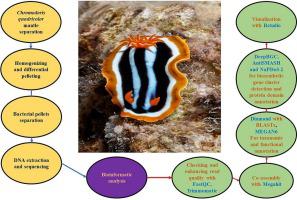Marine Genomics ( IF 1.9 ) Pub Date : 2023-04-11 , DOI: 10.1016/j.margen.2023.101030 Engy Mahmoud 1 , Amro Hanora 1 , Salah Abdalla 1 , Ali A Abdelrahman Ahmed 1 , Samira Zakeer 1

|
Nudibranchs are colorful marine invertebrates having a diverse group of understudied animals. Recently, some nudibranch members have acquired some attention while others still have not. Chromodoris quadricolor is a member of the Red Sea nudibranch, which did not have the chance to get significant attention. Unlike various invertebrates, it lacks a shell suggesting that it must defend itself in other ways. Therefore, in the present study, we were concerned about the mantle-associated bacterial communities. Being essential partners of this dorid nudibranch system, we investigated their taxonomic and functional profiles. We performed a whole metagenomic shotgun approach for the mantle bacterial cells after a differential pelleting procedure. In this procedure, we separated most of the prokaryotic cells from the eukaryotic host cells. Our findings showed that the mantle-body part holds a diverse group of bacterial species relating mainly to Proteobacteria and Tenericutes phyla. There were novel findings regarding the bacterial members associated with the nudibranch mollusks group. Various species were not previously recorded as bacterial symbionts with nudibranchs. Those members were Bathymodiolus brooksi thiotrophic gill symbiont (23.2%), Mycoplasma marinum (7.4%), Mycoplasma todarodis (5%), and Solemya velum gill symbiont (2.6%). The presence of these bacterial species assumed a nutritional role to the host. However, some of these species were present in a high abundance, suggesting their important symbiosis with Chromodoris quadricolor. In addition, exploring the bacterial ability to produce valuable products resulted in the prediction of 2088 biosynthetic gene clusters (BGCs). We identified different gene cluster classes. Polyketide BGC class was the most represented. Others were related to fatty acid BGCs, RiPP, saccharide, terpene, and NRP BGC classes. Prediction of the activity of these gene clusters resulted in, mainly, an antibacterial activity. In addition, different antimicrobial secondary metabolites were also detected. These secondary metabolites are considered key components regulating the bacterial species interactions in their ecosystem. This suggested the significant contribution of these bacterial symbionts to protect the nudibranch host against predators and pathogens. Globally, it is the first detailed study concerned with both the taxonomic diversity and functional potentials of the bacterial symbionts associated with Chromodoris quadricolor mantle.
中文翻译:

与“Chromodoris quadricolor”地幔相关的细菌共生体的鸟枪法宏基因组分析
裸鳃类动物是色彩缤纷的海洋无脊椎动物,拥有多种未被充分研究的动物群。最近,一些裸鳃亚目成员获得了一些关注,而另一些则没有。四色金线菊是红海裸鳃类动物的一员,没有机会引起人们的广泛关注。与各种无脊椎动物不同,它没有外壳,这表明它必须以其他方式保护自己。因此,在本研究中,我们关注与地幔相关的细菌群落。作为这个 dorid nudibranch 系统的重要伙伴,我们调查了它们的分类学和功能概况。我们在差异造粒程序后对地幔细菌细胞进行了完整的宏基因组鸟枪法。在此过程中,我们将大部分原核细胞与真核宿主细胞分离。我们的研究结果表明,地幔体部分拥有一组不同的细菌物种,主要与变形杆菌和Tenericutes相关门。关于与裸鳃类软体动物组相关的细菌成员有新发现。以前没有将各种物种记录为与裸鳃类动物的细菌共生体。这些成员是Bathymodiolus brooksi 硫营养鳃共生体(23.2%)、Mycoplasma marinum (7.4%)、Mycoplasma todarodis (5%)和 Solemya velum 鳃共生体(2.6%)。这些细菌物种的存在对宿主起到了营养作用。然而,其中一些物种的丰度很高,表明它们与Chromodoris quadricolor有重要的共生关系. 此外,探索细菌生产有价值产品的能力导致了对 2088 个生物合成基因簇 (BGC) 的预测。我们确定了不同的基因簇类别。聚酮化合物 BGC 类代表最多。其他与脂肪酸 BGC、RiPP、糖类、萜烯和 NRP BGC 类有关。对这些基因簇活性的预测主要导致抗菌活性。此外,还检测到不同的抗菌次级代谢产物。这些次级代谢物被认为是调节其生态系统中细菌物种相互作用的关键成分。这表明这些细菌共生体对保护裸鳃亚目宿主免受捕食者和病原体的侵害做出了重大贡献。在全球范围内,Chromodoris 四色地幔。



























 京公网安备 11010802027423号
京公网安备 11010802027423号